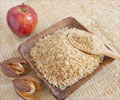About
‘Mirror, Mirror on the wall, who’s the fairest of them all!’ Between whole wheat flour (atta) & refined flour (maida); definitely refined flour!
Maida is used to cook sinful delicacies because it’s lighter and demands lesser work compared to atta that requires more attention in terms of kneading and leavening. Who wouldn’t prefer the easy way out in this case! For the benefit of those who do not know the difference between whole wheat flour and refined flour here’s what you need to know. The whole wheat grain when ground with the skin and germ yields brownish flour called atta. The same when refined further or ground without the skin yields whiter flour called maida. Hence, the names “whole wheat flour” and "refined flour”.
While atta has existed in the food cycle since ages, its usage was limited to minimal compared to maida, the fair flour that dominates the food industry especially baking. Whole wheat is rich in “gluten” a protein content that increases the elasticity of the flour. It’s the gluten in the atta that helps in the rolling of thin phulkas and chapathis; but beware, it requires a bit of tending and extra kneading not required in the case of maida. The gluten content of wheat is perhaps the only ingredient that does not agree with certain people as it can cause allergy; other than that the whole grain is extremely nutritious and healthy compared to the Refined or All purpose flour.
Whole wheat grain is power packed with nutrients. Its consists of the bran, germ and endosperm
- The bran is the outer cover of the seed and it is rich in minerals, fibers, vitamin B and phytochemicals.
- The germ is the second layer beneath the bran, rich in vitamin B and E and has traces of minerals and phytochemicals.
- Endosperm is the innermost part of the whole wheat grain that is starchy and extremely rich in protein and carbohydrates.
Having said this, consumption of whole wheat products has a lot of benefits.
- It increases the feeling of satiation thereby, reducing hunger pangs and unnecessary eating.
- Whole wheat is fiber rich and so it helps with easy excretion of stool, relieving constipation.
- Since it stabilizes blood glucose levels, it’s a wise choice for diabetes.
- The minerals and vitamins present in whole wheat helps fight cancer, high blood pressure and many heart-related diseases.
- It’s said that, eating whole grain daily reduces fatigue and anemia by providing an adequate amount of iron to the body.
On the other hand, maida does yield attractive and mouth-watering results when used in any form of cooking, but does not contain even quarter the amount of health benefits that whole wheat grain has to offer. As a matter of fact the scrumptious donuts, pastries, cakes and many more dishes made out of maida are extremely delicious but cause hyperacidity and constipation. Since they are lighter and rise faster, maida demands more oil or butter while baking or cooking, one reason why bakers prefer maida to atta. No wonder this paves the way to obesity or fat storage in the body.

Incidentally, all-purpose flour or maida has been consumed for time immemorial, so the sudden hype about preference for whole wheat flour instead of refined flour has left many people confused. It can be debated that in the past the kind of work both men and women were involved in and the diet they consumed was balanced. Back then, consumption of rich food was well compensated by equitable burn out through hard labor, which is not the case today because of the sedentary lifestyle and desk jobs. So, the next time you consume naan, pastry, bread, biscuits made of maida be sure to have it within limits or maintain a routine workout; this would help break down the fat storage in the body piled because of consuming food made of maida. Maida spikes up sugar in the blood, proving it’s consumption in excess to be unsafe unhealthy.
If an individual consumes maida based food and does not balance it out with other mineral and vitamin-rich food, then the call for whole grain and meticulous nutrient rich diet consumption becomes an important agenda. Maida cannot be ruled out completely from the food chain. No matter how much emphasis is given to healthy eating concepts, old habits die hard! Instead of removing it from your system completely its usage can be reduced by mixing it with atta.
These days, people are becoming health conscious. The food industry too is catering to this increase in demand for healthy food. But again, there’s more to what meets the eye. For example, the whole wheat bread you see on your store shelves claimed to be made of whole wheat is actually not made from whole wheat alone. They definitely contain a mix of both atta and maida. Bread made of atta will be heavier and less soft compared to its counterpart. These kinds of substitutes are lot better than consuming bread made fully of maida.
Atta is any day better than maida. It would be a wise man’s folly to think that atta cannot be substituted in baking instead of maida. Again, if an individual maintains a healthy diet chart and follows the regular workout and consumes a proportionate amount of food, then no food is unhealthy in any ways. The healthy food concept is basically for people who are battling with time and the stress of their jobs and end up eating food, that’s just ‘junk’ to their body.






